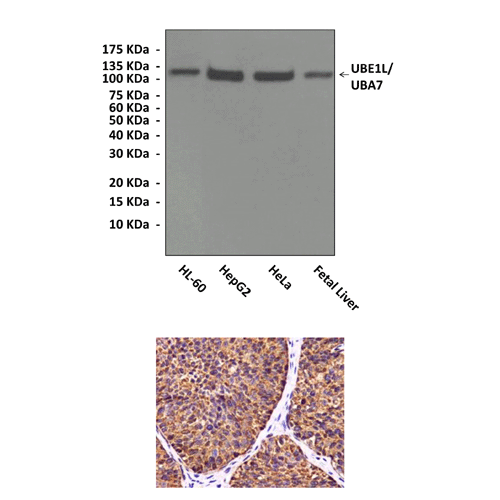Anti-UBE1L/UBA7: Mouse UBE1L/UBA7 Antibody |
 |
BACKGROUND Ubiquitin activating enzyme 1-like protein (UBE1L, also called UBA7), a monomeric protein of 120 kDa, was identified as the activating enzyme for the ubiquitin-like protein interferon-stimulated gene, 15 kDa (ISG15). Activating enzymes play critical roles in conjugation of ubiquitin as well as other ubiquitin-like proteins. Sequence homology between activating enzymes supports the hypothesis that this family of enzymes, which includes the activating enzymes for ubiquitin, small ubiquitin-related modifier (SUMO), and NEDD8, engage similar mechanisms during conjugate activation. The most distinctive property of UBE1L is its selectivity in transferring its ISG15 substrate to a single E2 enzyme, UbcH8, an E2 that has been reported to also function in Ub conjugation. ISG15, originally identified as an interferon-induced species, contains tandem ubiquitin homology domains and a carboxyl-terminal LRGG motif conserved between ubiquitin-like protein modifiers. ISG15 forms covalent conjugates with intracellular proteins following diverse signals such as type I IFN treatment and bacterial or viral challenges. ISG15 has been shown to play important role in a variety of pathways critical for signaling diverse second messenger pathways or cellular responses. Both UbE1L–/– and ISG15–/– mice display increased susceptibility to influenza B virus infection, including non-mouse-adapted strains.1
In addition, UBE1L (UBA7) is a long-suspected 3p21.3 residing tumor suppressor gene. Its expression was significantly increased in cancer cells by retinoids, natural and synthetic derivatives of vitamin A, which are active in cancer therapy and chemoprevention. The UBE1L-ISG15 pathway was proposed to target lung carcinogenesis by inhibiting cyclin D1 expression.2 It was also reported that UBE1L expression was induced during RA-mediated acute promyelocytic leukemia (APL) cell differentiation. UBE1L induced ISG15ylation of the PML domain of PML/RARα, causing its repression.3
In addition, UBE1L (UBA7) is a long-suspected 3p21.3 residing tumor suppressor gene. Its expression was significantly increased in cancer cells by retinoids, natural and synthetic derivatives of vitamin A, which are active in cancer therapy and chemoprevention. The UBE1L-ISG15 pathway was proposed to target lung carcinogenesis by inhibiting cyclin D1 expression.2 It was also reported that UBE1L expression was induced during RA-mediated acute promyelocytic leukemia (APL) cell differentiation. UBE1L induced ISG15ylation of the PML domain of PML/RARα, causing its repression.3
REFERENCES
1. Lai, C. et al: J. Virol. 83:1147-51, 2009
2. Pitha-Rowe, I. et al: Cancer Res. 64:8109-15, 2004
3. Shah, S.J. et al: Mol. Cancer Ther. 7:905-14, 2008
2. Pitha-Rowe, I. et al: Cancer Res. 64:8109-15, 2004
3. Shah, S.J. et al: Mol. Cancer Ther. 7:905-14, 2008
Products are for research use only. They are not intended for human, animal, or diagnostic applications.
Параметры
|
Cat.No.:
|
CG1779
|
|
Antigen:
|
Short peptide from human UBE1L sequence.
|
|
Isotype:
|
Rabbit IgG
|
|
Species & predicted
species cross-
reactivity ( ):
|
Human, Mouse, Rat
|
|
Applications &
Suggested starting
dilutions:*
|
WB 1:1000
IP 1:50
IHC 1:100
ICC 1:50
FACS 1:50
|
|
Predicted Molecular
Weight of protein:
|
120 kDa
|
|
Specificity/Sensitivity:
|
Detects endogenous UBE1L proteins without cross-reactivity with other family members.
|
|
Storage:
|
Store at -20°C, 4°C for frequent use. Avoid repeated freeze-thaw cycles.
|
*Optimal working dilutions must be determined by end user.
Информация представлена исключительно в ознакомительных целях и ни при каких условиях не является публичной офертой








